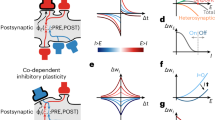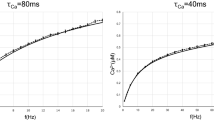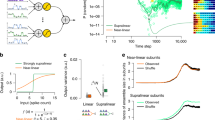Abstract
Activity-dependent changes in synaptic efficacy or connectivity are critical for the development1, signal processing2 and learning and memory functions3,4,5,6 of the nervous system. Repetitive correlated spiking of pre- and postsynaptic neurons can induce a persistent increase or decrease in synaptic strength, depending on the timing of the pre- and postsynaptic excitation7,8,9,10,11,12,13. Previous studies on such synaptic modifications have focused on synapses made by the stimulated neuron. Here we examine, in networks of cultured hippocampal neurons, whether and how localized stimulation can modify synapses that are remote from the stimulated neuron. We found that repetitive paired-pulse stimulation of a single neuron for brief periods induces persistent strengthening or weakening of specific polysynaptic pathways in a manner that depends on the interpulse interval. These changes can be accounted for by correlated pre- and postsynaptic excitation at distant synaptic sites, resulting from different transmission delays along separate pathways. Thus, through such a ‘delay-line’ mechanism, temporal information coded in the timing of individual spikes14,15,16,17 can be converted into and stored as spatially distributed patterns of persistent synaptic modifications in a neural network.
This is a preview of subscription content, access via your institution
Access options
Subscribe to this journal
Receive 51 print issues and online access
$199.00 per year
only $3.90 per issue
Buy this article
- Purchase on Springer Link
- Instant access to full article PDF
Prices may be subject to local taxes which are calculated during checkout




Similar content being viewed by others
References
Katz,L. C. & Shatz,C. J. Synaptic activity and the construction of cortical circuits. Science 274, 1133–1138 (1996).
Abbott,L. F., Varela,J. A., Sen,K. & Nelson,S. B. Synaptic depression and cortical gain control. Science 275, 220–224 (1997).
Squire,L. R. Memory and Brain (Oxford Univ. Press, New York, 1987).
Churchland,P. S. & Sejnowski,T J. the Computational Brain (The MIT Press, Cambridge, MA, 1992).
Bliss,T. V. & Collingridge,G. L. A synaptic model of memory: long-term potentiation in the hippocampus. Nature 361, 31–39 (1993).
Goda,Y. & Stevens,C. F. Synaptic plasticity: the basis of particular types of learning. Curr. Biol. 6, 375–378 (1996).
Levy,W. B. & Steward,O. Temporal contiguity requirements for long-term associative potentiation/depression in the hippocampus. Neuroscience 8, 791–797 (1983).
Markram,H., Lubke,J., Frotscher,M. & Sakmann,B. Regulation of synaptic efficacy by coincidence of postsynaptic APs and EPSPs. Science 275, 213–215 (1997).
Magee,J. C. & Johnston,D. A synaptically controlled, associative signal for Hebbian plasticity in hippocampal neurons. Science 275, 209–213 (1997).
Bell,C. C., Han,V. Z., Sugawara,Y. & Grant,K. Synaptic plasticity in a cerebellum-like structure depends on temporal order. Nature 387, 278–281 (1997).
Debanne,D., Gahwiler,B. H. & Thompson,S. M. Long-term synaptic plasticity between pairs of individual CA3 pyramidal cells in rat hippocampal slice cultures. J. Physiol. (Lond.) 507, 237–247 (1998).
Zhang,L. I., Tao,H. W., Holt,C. E., Harris,W. A. & Poo,M.-m. A critical window for cooperation and competition among developing retinotectal synapses. Nature 395, 37–44 (1998).
Bi,G.-q. & Poo,M.-m. Synaptic modifications in cultured hippocampal neurons: dependence on spike timing, synaptic strength, and postsynaptic cell type. J. Neurosci. 18, 10464–10472 (1998).
Hopfield,J. J. Pattern recognition computation using action potential timing for stimulus representation. Nature 376, 33–36 (1995).
Singer,W. & Gray,C. M. Visual feature integration and the temporal correlation hypothesis. Annu. Rev. Neurosci. 18, 555–86 (1995).
Gerstner,W., Kempter,R., van Hemmen,J. L. & Wagner,H. A neuronal learning rule for sub-millisecond temporal coding. Nature 383, 76–81 (1996).
Strong,S. P., Koberle,R., De Ruyter Van Steveninck,R. R. & Bialek,W. Entropy and information in neural spike trains. Phys. Rev. Lett. 80, 197–200 (1998).
Malenka,R. C. & Nicoll,R. A. NMDA-receptor-dependent synaptic plasticity: multiple forms and mechanisms. Trends Neurosci. 16, 521–527 (1993).
Linden,D. J. & Connor,J. A. Long-term synaptic depression. Annu. Rev. Neurosci. 18, 319–357 (1995).
Miles,R. & Wong,R. K. Latent synaptic pathways revealed after tetanic stimulation in the hippocampus. Nature 329, 724–726 (1987).
Turrigiano,G., Abbott,L. F. & Marder,E. Activity-dependent changes in the intrinsic properties of cultured neurons. Science 264, 974–977 (1994).
Buzsàki,G. Polysynaptic long-term potentiation: a physiological role of the perforant path–CA3/CA1 pyramidal cell synapse. Brain Res. 455, 192–195 (1988).
Buonomano,D. V., Hickmott,P. W. & Merzenich,M. M. Context-sensitive synaptic plasticity and temporal-to-spatial transformations in hippocampal slices. Proc. Natl Acad. Sci. USA 94, 10403–10408 (1997).
Carr,C. E. & Konishi,M. A circuit for detection of interaural time differences in the brain stem of the barn owl. J. Neurosci. 10, 3227–3246 (1990).
Kristan,W. B J. He's got rhythm: single neurons signal timing on a scale of seconds. Nature Neurosci. 1, 643–645 (1998).
Tank,D. W. & Hopfield,J. J. Neural computation by concentrating information in time. Proc. Natl Acad. Sci. USA 84, 1896–1900 (1987).
Moore,J. W., Choi,J.-S. & Brunzell,D. H. in Timing of Behaviour (eds Risenbaum, D. A. & Collyer, C. E.) 3–34 (MIT Press, Cambridge, MA, 1998).
Abeles,M. Corticonics (Cambridge Univ. Press, Cambridge, 1991).
Fitzsimonds,R. M., Song,H. J. & Poo,M.-m. Propagation of activity-dependent synaptic depression in simple neural networks. Nature 388, 439–448 (1997).
Rae,J., Cooper,K., Gates,P. & Watsky,M. Low access resistance perforated patch recordings using amphotericin B. J. Neurosci. Methods 37, 15–26 (1991).
Acknowledgements
We thank X. Wang for culture preparations and B. Berninger, W. Kristan, L. Zhang, A. Schinder and S. Andersen for helpful discussions and comments on the manuscript. Supported by grants from NIH (M.P.) and a President's Postdoctoral Fellowship from the University of California and a training grant from NIH (G.B.).
Author information
Authors and Affiliations
Corresponding author
Rights and permissions
About this article
Cite this article
Bi, Gq., Poo, Mm. Distributed synaptic modification in neural networks induced by patterned stimulation. Nature 401, 792–796 (1999). https://doi.org/10.1038/44573
Received:
Accepted:
Issue Date:
DOI: https://doi.org/10.1038/44573
This article is cited by
-
Biphasic Cholinergic Modulation of Reverberatory Activity in Neuronal Networks
Neuroscience Bulletin (2023)
-
Enhanced intrathalamic morphological connectivity in patients with chronic insomnia
Brain Imaging and Behavior (2023)
-
IGZO-based neuromorphic transistors with temperature-dependent synaptic plasticity and spiking logics
Science China Information Sciences (2022)
-
Subtly altered topological asymmetry of brain structural covariance networks in autism spectrum disorder across 43 datasets from the ENIGMA consortium
Molecular Psychiatry (2022)
-
Chronic Cyanuric Acid Exposure Depresses Hippocampal LTP but Does Not Disrupt Spatial Learning or Memory in the Morris Water Maze
Neurotoxicity Research (2021)
Comments
By submitting a comment you agree to abide by our Terms and Community Guidelines. If you find something abusive or that does not comply with our terms or guidelines please flag it as inappropriate.



